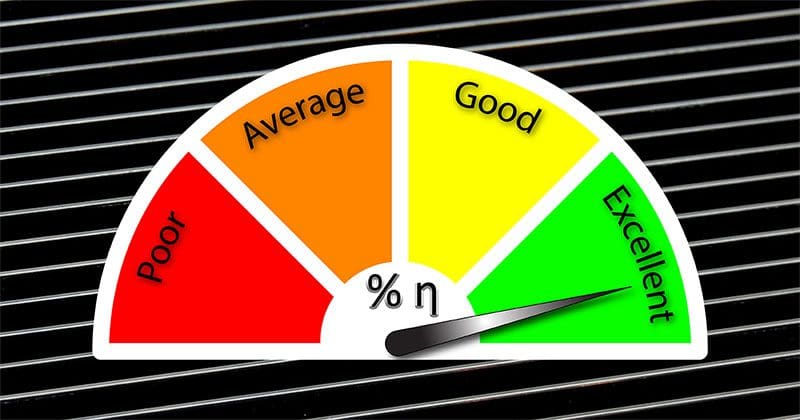For car audio enthusiasts, especially those interested in competing in SPL competitions, amplifier efficiency should be one of their primary concerns. In this first of three articles on efficiency, we take a close look at the Rockford Fosgate M5-1000X1 Class-D subwoofer amp and analyze how well it makes use of power at different output levels.
What Is Car Audio Subwoofer Amp Efficiency?
In the case of car audio amplifiers, or this specific analysis of a Class-D subwoofer amp, some of the voltage and current from your alternator and battery are converted into heat. This is wasted energy. Don’t fret, and it happens with every electronic device – even if the heat produced is minuscule.
When we talk about efficiency, we look at how much power is sent to the load (speakers) compared to how much is consumed by the amplifier. We set up the Rockford Fosgate M5-1000X1 that Dave MacKinnon reviewed for BestCarAudio.com in early 2021 on the bench. First, we used our D’Amore Engineering AMM-1 to confirm that we had a 1.0-ohm resistive load. Next, we measured output voltage, input voltage and input current at 60 points between idle and an output level of 800 watts where the CLEAN circuit put the amp into protection.
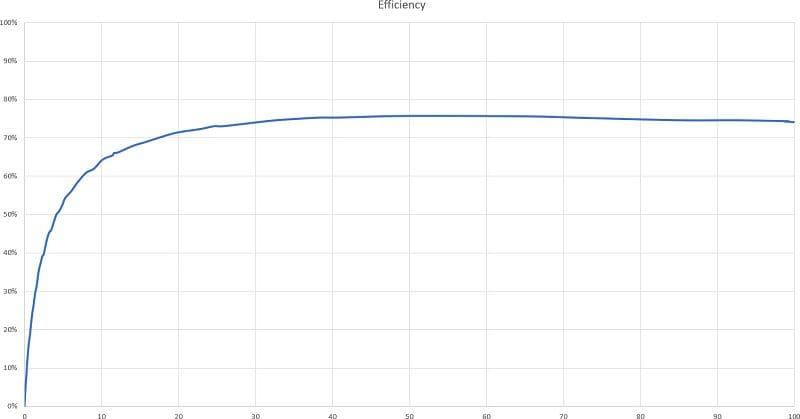
A few things to note. The amplifier idles at about 1.5 amps of current. That’s the power it takes to drive the circuitry without the amp producing any power. At output levels below about 1 watt, this idle current significantly outweighs the current required to deliver power to the speaker. As such, the efficiency in this range is well under 5%.
If you analyze the graph above, you can see that the efficiency increases very quickly to over 70% by the time the amplifier produces 140 watts. At this level, the current draw is 17.45 amps. Beyond that, efficiency increases to a maximum of 76% while delivering 400 watts. The current draw at that level is 49.78 amps.
Graphs like this have been floating around the car audio industry for many years and are often combined with a graph of a Class-AB amplifier to highlight the efficiency benefits of the Class-D design. One problem with this way of looking at the data is that the power delivery scale is linear. In the real world of reproducing audio, we know that we need to double the power to a speaker every time we want to increase the output by 3 dB. That’s a logarithmic requirement. Let’s analyze this same data with the percentage of maximum power on a logarithmic scale.
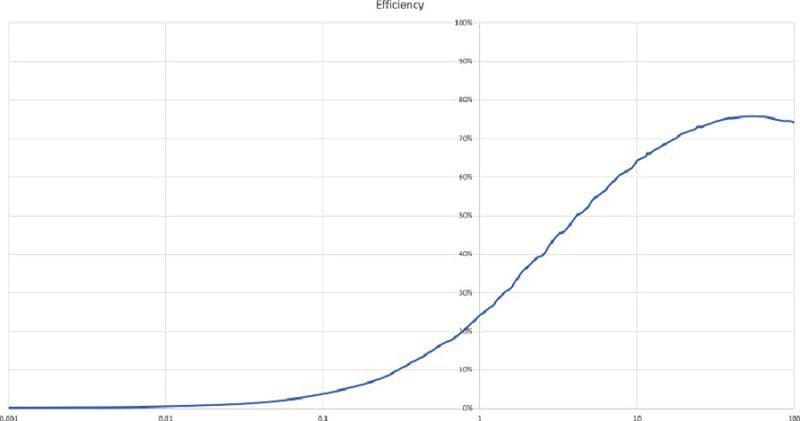
Suddenly, our amplifier doesn’t look quite as efficient. The numbers haven’t changed, though; it’s just the way we’re analyzing them. You may only need 5 or 10 watts to drive your subwoofer at very low volume levels. At these levels, the amplifier wastes a LOT of power as heat. The efficiency in this range is only 18 to 27%. This means that around a quarter of the power going into the amp is going to your speakers; the rest is running the amplifier’s signal processing and is being converted to heat.
How Manufacturers Specify Efficiency
When you’re looking at amplifier efficiency specifications, the odds are very good that they’ve been taken with the amp at full power. In almost every case, this is the level at which a Class-D amplifier makes the best use of the power it’s drawing from your electrical system.
What matters much more in the real world is what the amp is doing at 10% or 25% of its rated output. This is where 95% of users spend most of their time listening to music. More efficiency in this range means less draw on the electrical system. Efficiency is paramount for marine applications where we might be running on batteries for several hours. It’s not uncommon to find one amplifier that draws half as much current to produce the same output as another model with worse efficiency, especially when the amplifier is loaded down.
Efficiency and Load Impedance
One last item we’ll look at is efficiency versus the current required to produce power in the load. It would be impossible to count the number of times we’ve heard someone suggest loading an amp down with additional speakers or the use of lower impedance speakers to produce more power. If the power supply in the amp can deliver the current, sure, you get more. The question is, is there a cost to this power? Let’s see how our test amp behaves in terms of efficiency when driving a 2-ohm load.
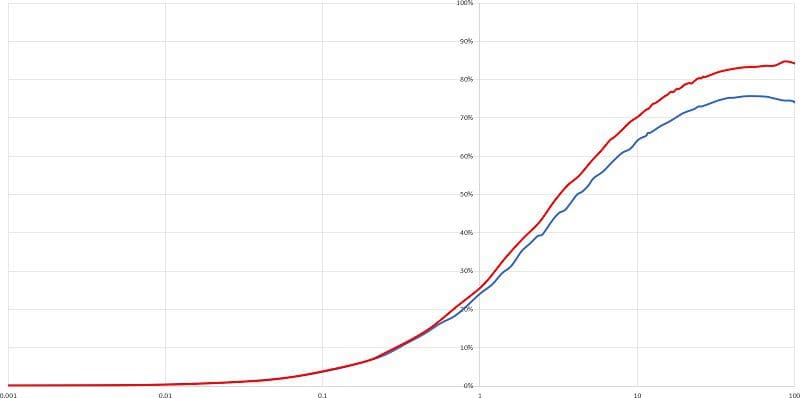
As you can see, the amp makes better use of power when connected to a 2-ohm load. The peak efficiency is up to 84.7% at an output level of 691 watts, with the amp drawing 58.1 amps of current. Compare that to the 1-ohm load, and the amp was drawing 71.5 amps to make the same power. Those extra 13 amps of current are wasted as heat.
It’s also worth noting that the amp produced more power in this 2-ohm load configuration before the CLEAN output distortion indicator was illuminated. Instead of 800.3 watts, it produced 865.3 watts. That’s 8.1% more power, for free, with less current draw and less heat. Sooo … if the amplifier you’ve chosen is rated to produce the same or even remotely similar power levels into 2- and 1-ohm loads, please don’t load it down.
Does Amplifier Temperature Effect Efficiency?
While we had the Rockford back on the bench, we took one more set of measurements. We wanted to know if the amplifier would become less efficient as it got hotter. Now, it’s crucial to keep in mind that this particular test will be specific to this amplifier from this company. There’s no way to predict if other designs work the same way. So we started the 2-ohm testing with the amplifier’s heat sink at 19 degrees Celsius and measured its efficiency. Then, we repeated the measurements as the temperature rose to 45, 50, 55 and 60 degrees. We’d have gone farther, but our load resistors were starting to make some strange crackling noises.
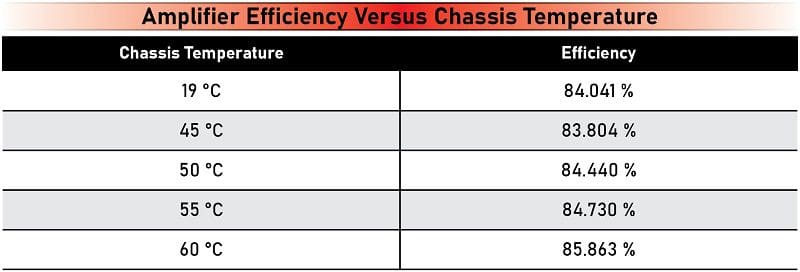
If someone had asked us to predict how the amp would behave, we’d have put all our chips on predicting that efficiency would decrease as the amp heated up. It only makes sense as wires, components and traces on the circuit board would increase resistance with temperature. The findings are very interesting and say a lot about the work the designers at Rockford Fosgate put into their products.
With Great Power Comes Increased Efficiency
There are three takeaways from this experiment. First, if you need a small amplifier for your midrange speakers or tweeters, choose one that only makes as much power as you need. A 150-watt amp is overkill when you’ll only use 10 or maybe 20 watts on a midrange driver. Second, if you compete in SPL competitions, choose a speaker load impedance that balances power production with amplifier efficiency. You may be throwing away power in the form of heat by loading your amplifiers down too much. If the limiting factor in your audio system is the ability to feed the amp, choosing the most efficient solution is crucial.
Last and certainly not least, amplifier efficiency depends on output level. Our testing shows that efficiency increases as power output approaches the rated output level when it comes to name-brand Class-D car audio amplifiers. Posting a single value on a website or in a brochure (do companies still make brochures?) doesn’t tell you much about the design or how efficient the amp will be when used at low power levels.
When it comes time to shop for an amplifier for your car or truck, drop by a local specialty mobile enhancement retailer and talk with them about the options for your vehicle. They’ll help you choose the right solution and integrate it into your vehicle so that it sounds excellent and functions reliably for many decades.
